#personajes históricos
Text
Este es el nivel:
Ellos sí que son unos personajes históricos
19 notes
·
View notes
Text
4 notes
·
View notes
Video
youtube
Top 10 Frases de Personajes Históricos y su relevancia en la actualidad
#youtube#historia#personajes históricos#nelson mandela#artistóteles#john f kennedy#sabiduría#pensadores#conocimientos
0 notes
Text
El maestro de la fuga de Jonathan Freedland
Hoy os hablamos de el libro #Elmaestrodelafuga de @Freedland y publicado por @edit_planeta y yo me pregunto ¿por qué Walter Rosemberg que logró escapar de #Auschwitz es tan desconocido? Os invitamos a leer la #reseña de un libro que no deja indiferente
,
Siempre digo que me fijo mucho en las portadas de los libros ya que según me transmiten muchas veces elijo pero, en este caso, no fue así. Una portada oscura con una pequeña imagen de las vías del tren hacia ese lugar llamado Auschwitz y unas letras amarillas con el título no es que sea, especialmente, llamativa pero sí muy efectiva objetivamente ya que es un reflejo de una realidad que vivieron…

View On WordPress
#editorial Planeta#Historia#Historia de Europa#Jonathan Freedland#No ficción novelada#Personajes históricos#Planeta#Planeta de Libros#Segunda guerra mundial
0 notes
Text
¡Conviértete en un experto narrador! Escribe textos descriptivos basados en tus investigaciones históricas
✍️📚 ¿Quieres ser un maestro de la descripción? ¡Aprende a escribir textos descriptivos sobre personajes históricos con nuestra última entrada en el blog! ¡Sigue nuestros consejos y actividades! #escritura #historia #educación
¡Hola de nuevo, queridos estudiantes! En nuestra última entrada, aprendimos a investigar personajes históricos utilizando fuentes confiables y a organizar la información recopilada. Ahora vamos a dar un paso más y aprenderemos cómo usar esa información para escribir un texto descriptivo interesante y bien estructurado.
(more…) “”

View On WordPress
#Cuarto grado#escritura#investigación#Lengua materna#organización#personajes históricos#texto descriptivo
0 notes
Text
As I promised, let's start with the bookscans:
Al-ANDALUS. PERSONAJES HISTÓRICOS
(Al Andalus. Historical figures)
Concepción Masiá
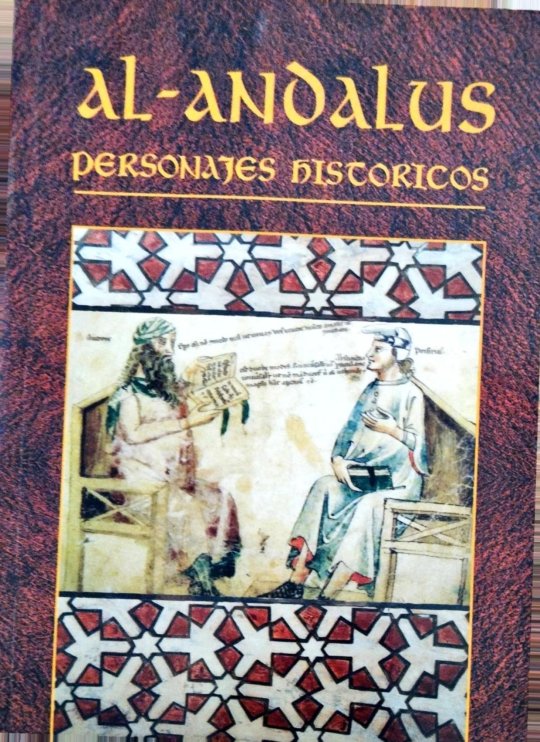
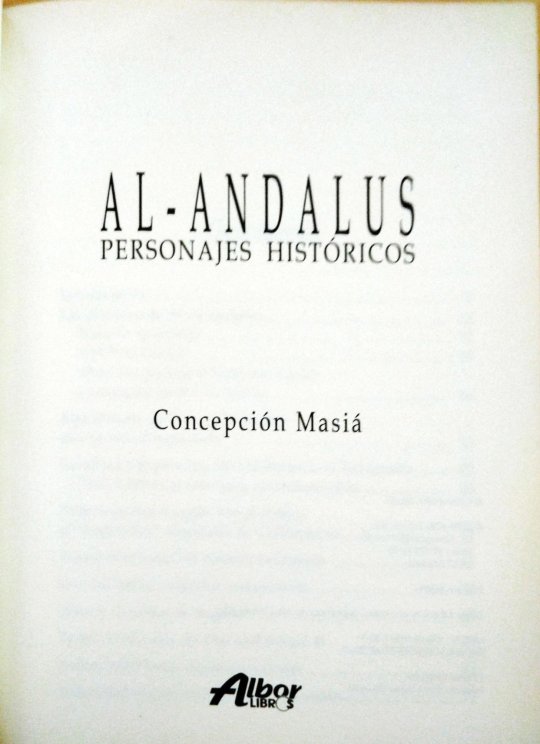

Summary
Introduction.................................. 9
The precursors of al-Andalus.....13
Count Don Julián....................13
Tarif ben Malluk. ....................15
Musa ben Nusayr and Tariq ben Ziyad: the conquerors of Spania...........16
Abd al-Aziz: a good governor with an unfortunate fate ..........................25
The Odyssey of Prince Abd al-Rahman the Immigrant......................................29
Abd al-Rahman was only twenty-five years old.........................................36
Sulayman ben Yaqzan ben al-Arabi: Charlemagne's deceived "deceiver" ........................... ...........41
Amrus ben Yusuf: the muladí of Huesca
.............................................................47
The “rabadies”: adventurous spirits.. ..............................................53
Ziryab: the singer of Baghdad........61
Tarub: the favorite of Abd al-Rahman II...............,...........................................67
Abbas ben Firnas: the first aviator............................ ......................73
Yahya ben Hakan al-Bakri: the miserly poet.....................................................77

Abd al Chabbar and Sulayman ben Martin: the rebels of Mérida..........................81
Eulogio and Álvaro de Córdoba:
pursuing martyrdom..........................85
The Andalusian Vikings..................... 95
The emir Abd Allah distrust and death...............................….................... 101
Musa ben Musa ben Qasi: the third king of Spain.......................................................107
Ibn Hafsun: the unredeemed rebel.....115
Abu Alí al-Sarrach: the Andalusian missionary. ...........................................125
Ibn Masarra: a freethinker in Spanish Islam.......,...........,...................................131
Abd al-Rahman III:
the first independent caliph of al-Andalus. ...........,................................137
Hasday ibn Shaprut:
the Jewish doctor of Abd al-Rahman III............ ....... ...................... ................... 145
Andalusians in France: the “Moorish kingdom” of Fraxinetum....................... 151
Rabbi ben Zayd: Bishop Recemundo............................................. 157
Al-Hakam al-Mustansir bi-llah:
passion for culture.................................. 161
Ibn Abd Rabbhi, the encyclopedist,
and Ibn Futais, the collector.................. 167
Al-Mansur “the Victorious” ...................171
Hisham II and Sanchuelo: misrule. .......191
Abu Muhammad Ali ibn Hazm:
The pigeon neackle................................209
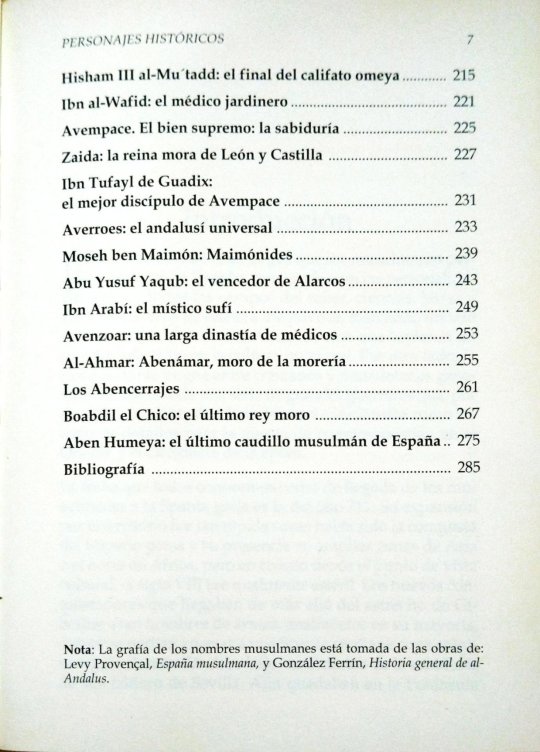
Hisham III al-Mu'tadd: the end of the Umayyad caliphate...............................215
Ibn al-Wafid: the gardener doctor.....221
Avempace. The supreme good: wisdom...................................................225
Zaida: the Moorish Queen of Leon and Castile........................................................227
Ibn Tufayl of Guadix:
the best disciple of Avempace................. ............................ .231
Averroes: the universal Andalusian....233
Moseh ben Maimon: Maimonides..... ..239
Abu Yusuf Yaqub: the winner of Alarcos......................................................243
Ibn Arabi: the Sufi mystic.....................249
Avenzoar: a long dynasty of doctors. ...................................................253
Al-Ahmar: Abenámar, Moor of the Morería. ...,...............................................255
The Abencerrajes. ..................................261
Boabdil the Younger: the last Moorish king ............................................................267
Aben Humeya: the last Muslim leader of Spain................ ..........................................275
Bibliography .............................................285
Note: The spelling of Muslim names is taken from the works of: Levy Provençal,
Muslim Spain, and González Ferrín, General History of al-Andalus.

Introduction
In the long eight hundred years that the Muslims remained in Spain, there were many personalities who, in all the fields of knowledge, sciences, letters and arts, stood out unequivocal, marking a milestone not only in the culture of al-Andalus, but that had a relevant character in universal culture.
On the other hand, the almost constant struggle between Christians and Muslims would also generate a whole series of great warriors who, for example, the infante Don Juan Manuel considered the best gifted for the war of all those who existed in the East and the West of their time.
The date that we all know as the arrival of the Muslims to Gothic Spania dates back to the year 711. Its expansion throughout the territory was so rapid as had been the conquest of the Persian empire and its presencein large areas of Asia or North Africa, but from a cultural point of view, the 8th century was totally sterile. The new conquerors who arrived from beyond the Strait of Gibraltar, were men at arms, mostly illiterate, who could do little contribute to a Christian Spania whose culture continued to develop under the dictates of the wisdom of Saint Isidore of Seville. Still they were left on the Peninsula
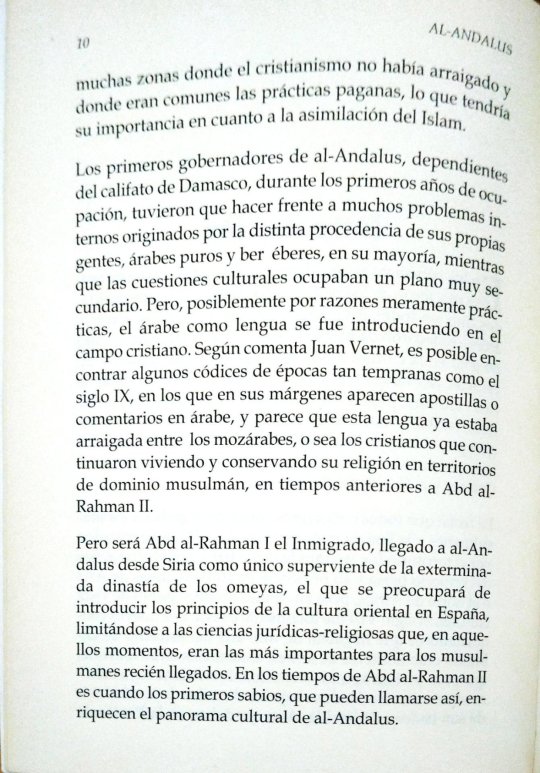
many areas where Christianity had not taken root and its importance regarding the assimilation of Islam.
The first governors of al-Andalus, dependent on Caliphate of Damascus, during the first years of occupation
had to face many enormous internal problems, originated by the different origins of their own people, Arabs
and berebers, mostly, while cultural issues occupied a very secondary level. But, possibly for purely practical reasons, Arabic as a language was introduced into the Christian field. According to Juan Vernet, it is possible to find
some codices from times as early as the 9th century, that in its margins appear apostilles or comments in Arabic,
and it seems that this language was already rooted among the Mozarabs,
that is, the Christians who continued to live and preserve their religion in Muslim-dominated territories, in times
before Abd al-Rahman II.
But it will be Abd al-Rahman I the Immigrant, who arrived in al-Andalus from Syria as the only survivor of the exterminated Umayyad dynasty, the one who will be concerned with introducing the principles of oriental culture in
Spain, limiting itself to the legal-religious sciences that, in those moments, were the most important for the newly Muslims
arrived. It was during the time of Abd al-Rahman II that the first wise men, who can be called that, enrich the cultural landscape of al-Andalus.

Poets, doctors, philosophers, mathematicians, geographers, undefeated generals...All of them will give al-Andalus and Europe a series of works that, by their importance will be translated, searched, accepted and will serve as a basis for the western culture and Renaissance ideas, in such a way that many of the great sages of the Italian Renaissance considered that all knowledge of the time came from Muslim Spain, which all the wise men were of Andalusian origin. And when the political decline and the disintegration of the caliphate, will not stop birth, grow and develop distinguished minds that will continue to maintain,for a long time, the prestige of al-Andalus. Curiously, this situation will be repeated throughout the history of Spain, when the Arab occupation just be a memory. The Spanish Golden Age will coincide with decadence of the Austrias, when the country loses its pre-ponderance in Europe, and with the disaster of '98, with the loss for Spain of its last colonies, will produce a cultural and scientific renaissance that has been called the Silver age.
Through the pages of this book we want to highlight those figures who occupied a predominant place in the history of al-Andalus, although not all of them were necessarily Muslims, since that in that cultured and tolerant al-Andalus, many Jews and some other Christians showed their genius, and of those who, often, we know more about his works than about his biography. But whatever religion they had, they were all, after all, Andalusians, born and raised in the extensive lands of al-Andalus. As a matter of curiosity we will include some groups of characters
anonymous people who, due to their surprising
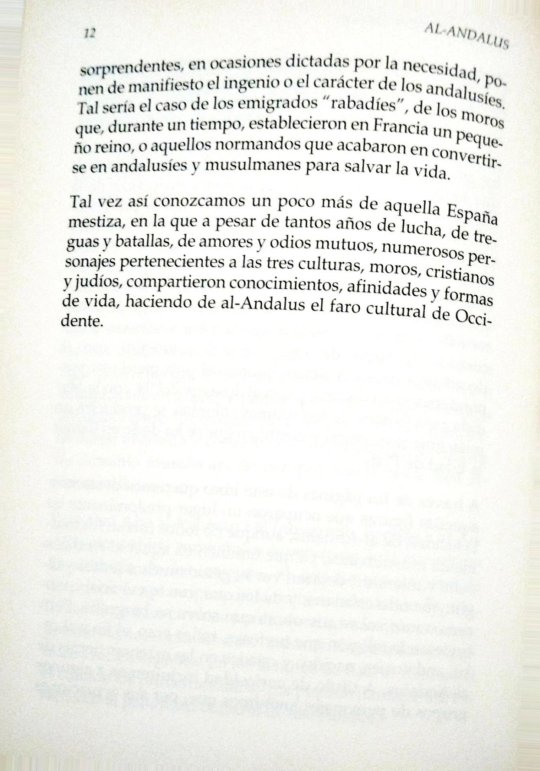
actions, on occasions dictated by necessity, they reveal the ingenuity or character of the Andalusians. Such would be the case of the "rabadíes", of the Moors who, for a time, established a small kingdom in France, or those Normans who ended up becoming Andalusians and Muslims to save their lives.
Perhaps this way we will learn a little more about that crossbred Spain, in which despite so many years of struggle, truces and battles, mutual loves and hates, numerous characters belonging to the three cultures, Moors, Christians and Jews shared knowledge, affinities and forms of
life, making al-Andalus the cultural beacon of the West.

The precursors of al-Andalus
Count Don Julián
The conquest of Morocco had been carried out quickly, but shallow. The Berbers were only subdued after a fierce resistance, defeated by an ambitious general who had just been appointed governor of Ifriqiya and Maghrib. His successes in these lands
They would prepare the ground for him to be the one to set his eyes and, also
his troops, over Gothic Spania. It was Musa ben Nusayr.
Musa, with the help of one of his sons, took possession of Tangier, and demanded that the subjugated tribes hostage to educate them in the new faith, which in turn, became propagandists of Islam, leaving in the conquered Morocco
Arab lieutenants, including General Tariq ben Ziyad, he turned to Ifriqiya. But it seems that the Ceuta square remained
in the hands of a Christian, the so-called Count Don Julián, who would have a
determining role in this entire story. We could consider it as a precursor of that al-Andalus that was about to be born.
#bookblr#book scans#historyblr#history books#al andalus#al andalus. personajes históricos#al andalus. historical figures#history#spanish history#musa ibn nusayr#tariq ibn ziyad#conde don julián#count don julián#count julian
27 notes
·
View notes
Text
Sor Juana Inés de la Cruz
Sor Juana Inés de la Cruz
#aperturaintelectual #palabrasbajollave
@tmoralesgarcia1
Thelma Morales García

View On WordPress
#AperturaIntelectual#palabrasbajollaveAI#17 de abril de 1995#Amado Nervo#Arte#Cultura#Ferrocarril Interoceánico#Inauguración del Centro Cultural Sor Juana Inés de la Cruz#Isidro Fabela Alfaro#Juana Inés de Asbaje y Ramírez de Santillana#La Décima Musa#Nepantla#Personajes#Poesía#Sitios Históricos#Sor Juana Inés de la Cruz#Tepetlixpa#Thelma Morales García
2 notes
·
View notes
Text
Playing Victoria 3 instead of studying:

The year is 1841... Juan Manuel de Rosas died under mysterious circumstances and so he was suceeded by Almirante Guillermo Brown (because he was the only other scripted character in the game) I took the chance to call for elections (I guess Brown finally decided to sit down and write a constitution) and the Nacional Autonomista party won (AY AY CARAMBA SON OLIGARCAS) but since they're mad at me because I want to abolish slavery (historically Argentina abolished the slave trade in 1813 and had a Freedom of Wombs law but this game doesn't model that) they refused to take power... On the elections they won. So the Unión Cívica Nacional (basically liberals) took power.
So our new president is *checks notes* Anastasio de Goyeneche, a religious conservative who heads a liberal goverment because his own party is too mad to take power. Makes sense.
Meanwhile in the economic front, I've tried to make Argentina's economy run and nothing works. Nobody wants to buy meat or sugar, this game does not simulate yerba mate, and I don't have a good economy to industrialize so I'm constantly just losing GDP and gaining it at random. I've been in a perpetual defecit despite the fact I'm doing mostly nothing.
Just your typical day in Argentina. Viva Anastasio de Goyeneche.
On the other hand Perú and Bolivia are still a confederation, that's nice.
#cosas mias#no esto no simula para nada las guerras entre federales y unitarios antes de que pregunten#sólamente hay dos personajes históricos Rosas y Brown el resto como mi amigo Anastasio son inventados#lo moddee un poco pero tendría que hacer bastante laburo para hacer las guerras civiles..... capaz lo haga
23 notes
·
View notes
Text

Primer personaje de mi relato «Romero»
🌿ROMERO 🌿 : Una mujer del siglo VIII que cambiará su personalidad huraña de forma inesperada para convertirse en heroína. Es campesina, pero sabe escribir, tiene pocas amigas y no ha conocido el amor.
(Autopublicaré el relato en Amazon y Wattpad en los próximos meses).
#mislibros#relato#literatura#escritora#oc#personaje#aesthetics#aesthetic#romero#relato histórico#wattpad#libros#libro
3 notes
·
View notes
Note
porfavor compartí tus pensamientos de evita quiero vivir mi hater lifestyle
La verdad no es nada que no pueda decir cualquier otrx argentinx jakdjakaj la idea de representar al peronismo así es ABSURDA y ni arranco a hablar del personaje de "Che" porque me da un síncope
#en defensa del musical de mierda ese la realidad es que no lo vi y he leído que la biografía de Evita en la que se habían empezado a basar#que fue escrita por una gorila hija de ingleses#no fue finalmente la fuente fundamental. y que de hecho tim rice se fascinó tanto con el personaje histórico que le puso eva a la hija#lo cual es MUY gracioso
1 note
·
View note
Text

Dominios de Tumblr: un nuevo lugar para albergar vuestro caos
Hola, habitantes de [tumblr]. ¿Qué tal estáis? Esperamos que disfrutando de un rato de desconexión y paz mental en las apacibles aguas de esta, nuestra comunidad. En medio de este remanso de tranquilidad, algunas personas incluso encontráis tiempo para ofrecer un servicio social indispensable: llenar el mundo de arte y repartir felicidad. Puede que lo vuestro sea crear fotos de perfil para disfrute de quienes os siguen, dibujar vuestros propios personajes originales con sumo detalle, hacer fotos de bellísimas setas silvestres o compartir vuestra vida rural con el mundo. Quizás dediquéis vuestros días a construir universos complejos para que otras personas participen en juegos de realidad alternativa, a crear memes de una serie de quince temporadas que no habéis podido superar aunque dejara de emitirse hace décadas o, simplemente, a cumplir el objetivo de todo ser humano: mantener ese espíritu puro y único que hay en vuestro interior bien vivo. Sea lo que sea lo que hagáis en Tumblr, ahora podéis ponerle el sello oficial con un dominio personalizado.
Contar con un dominio os dará una imagen más profesional en internet aunque, si lo que queréis es precisamente que no os tomen en serio, también tenemos direcciones que harán reír a medio mundo a carcajadas. En cualquiera de los dos casos, os permiten dejar aún más claro quiénes sois y cómo es vuestro espacio en internet.
Por supuesto, vuestras direcciones de siempre, nombredelblog.tumblr.com, seguirán siendo gratis. Simplemente, ahora tenéis la posibilidad de haceros con un dominio personal.
Para reservar vuestro pedacito de cielo en internet a través de Tumblr, solo tenéis que seguir estos pasos:
Haced clic en el icono con forma de silueta humana para acceder al menú de la cuenta y entrad en el apartado «Dominios» del menú desplegable.
Añadid toda la información, incluid vuestros datos de pago y ¡listo! Ya sois oficialmente una institución en Tumblr.
Los dominios activos y vinculados con un blog con anterioridad seguirán funcionando sin problemas (a menos que los desconectéis); sin embargo, a partir de ahora, tendréis que comprar cualquier dominio personalizado nuevo que queráis asociar a uno de vuestros blogs a través de nuestra plataforma.
Además, estamos diseñando un proceso que permita transferirlos y un servicio de conexión de dominios de pago.
Y, por si eso fuera poco, tenemos una oferta para todas las personas interesadas en hacerse con un dominio .blog para celebrar este momento histórico:
Primer año (si lo registráis antes del 31 de julio): 3,00 $
Primer año (si lo registráis entre el 1 de agosto y el 31 de diciembre): 5,00 $
Renovación anual: 10,00 $
¿Queréis saber si hay otros dominios disponibles? Podéis comprobarlo aquí. Si tenéis cualquier duda, este documento de ayuda incluye un montón de información útil.
¡Es hora de subir de nivel! Cread un refugio a vuestra medida e invitad a toda la comunidad de Tumblr a descubrirlo.
158 notes
·
View notes
Text
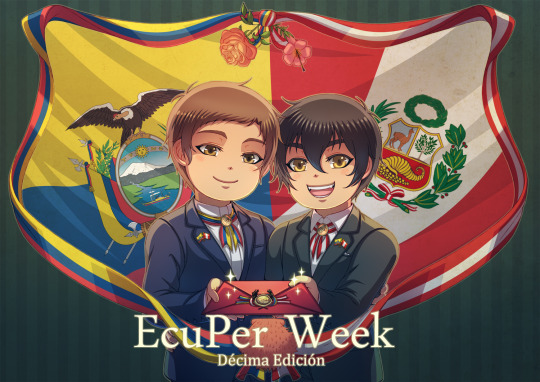
[Español]
Damas y Caballeros.-
En representación de los señores Miguel Prado y Francisco Burgos, nos complace invitarles cordialmente a la Décima Edición de EcuPer Week (también conocida como semana Perú/Ecuador) y la celebración del 25º Aniversario de la Paz entre Ecuador y Perú.
Fecha: Del 21 al 27 de octubre de 2023
Lugar: Twitter, Tumblr, Facebook e Instagram.
Un evento especial que conmemora un cuarto de siglo de paz y cooperación entre nuestras naciones. Durante esta semana, tendremos el honor de compartir experiencias, conocimientos y celebrar juntos este importante hito. Para participar, únicamente debe publicar en sus redes sociales cualquier cosa que desee -dibujos, fics, fanmixes ,etc- en donde aparezcan ambos personajes.
Adicionalmente, damos a conocer que en esta ocasión se utilizarán los siguientes tags como parte de esta celebración: #ecuperweek2023, #ecuperweek, como también los opcionales: #latinhetalia, #ecuper, #perecu.
Para más información, por favor referirse a nuestra cuenta en Twitter: @ecuperweek
Esperamos celebrar juntos este momento histórico.
Atentamente,
Miguel y Francisco
Presidentes de la EcuPerWeek
[For information in English, please follow the cut]
[English]
Greetings,
On behalf of Mr. Miguel Prado and Mr. Francisco Burgos, it is our pleasure to extend a cordial invitation to the Tenth Edition of the EcuPer Week (also known as the Peru/Ecuador week) and the commemoration of the 25th Anniversary of Peace between Ecuador and Peru.
Date: October 21st to 27th, 2023
Venue: Twitter, Tumblr, Facebook, and Instagram.
This special event marks a quarter-century of peace and cooperation between our nations. Throughout this week, we will have the honor of sharing experiences, knowledge, and celebrating this significant milestone together. To participate, simply post on your social media platforms anything you wish - be it drawings, fics, fanmixes, etc. - featuring both characters.
Furthermore, we would like to announce that the following tags will be used for this celebration: #ecuperweek2023, #ecuperweek, and optionally, #latinhetalia, #ecuper, #perecu.
For more information, please refer to our Twitter account: @ecuperweek.
We look forward to celebrating this historic moment together.
Yours sincerely,
Miguel and Francisco
Presidents of the EcuPer Week
56 notes
·
View notes
Text
“De todos los infortunios que afligen a la humanidad el más amargo es que hemos de tener conciencia de mucho y control de nada”
Heródoto

Fue un historiador y geógrafo griego, nacido en la antigua ciudad griega Jonia en Halicarnaso, famoso por su obra “Historia”, considerada una de las fuentes mas importantes de la descripción del mundo antiguo a gran escala y una de las primeras en prosa griega.
Aunque no se conocen muchos detalles de su vida, parece ser provenía de una familia aristocrática de la Asia Menor, lo cual le permitía pagar su educación, pues sus escritos reflejan un profundo aprendizaje en las mejores escuelas de la época.
Sus continuos viajes al parecer por voluntad, también dan pie a pensar que se trataba de un hombre de recursos.
Se cree que sirvió en el ejército de hoplita, pues sus descripciones de dicha batalla son bastante precisas y siempre se cuentan desde el punto de vista de un soldado de infantería.
Dedica buena parte de su obra a relatar la historia del imperio persa, así como de sus costumbres y gobernantes, y de las guerras que enfrentaron con los griegos.
Dedicó gran parte de su vida a efectuar viajes para obtener la información y los materiales que le permitieron escribir una gran obra de valor histórico y literario.
Se le considera padre de la historiografía, y la primera vez que se le cita de esta manera es en el ciceroniano De legibus, un texto de Marco Tulio Cicerón escrito alrededor del año 52 a.C.
Su obra “Historia”, que se describe literalmente como investigaciones, exploraciones, fue escrita probablemente en Turios, una ciudad de la magna Grecia en el Golfo de Tarento a corta distancia de Sibaris.
El conjunto fue dividido en 9 libros por su editor alejandrino del siglo III a.C. uno por cada musa; Clío, Euterpe, Talía, Melpómene, Terpsícore, Erato, Polimnia, Urania y Calíope, y en ellos narra con detalle Las Guerras médicas entre Grecia y Persia a principios de siglo V a.C., con especial énfasis en aspectos curiosos de los pueblos y personajes, al mismo tiempo que describe la historia, etnografía y geografía de su tiempo.
Para sus obras históricas recurrió a fuentes orales y escritas, aludiendo siempre a sus informadores, es decir, citando el origen de la Fuente de la siguiente forma; “Según los persas…”, o “a decir de los griegos” etc.
Sus libros abarcan temas tales como la historia de Creso, acontecimientos en Babilonia y Persia, geografía de Egipto, costumbres y animales de Egipto, costumbres de los Escitas, la conquista de Persia a Libia, y múltiples relatos de batallas de la época.
Al ser “La Historia” la primera obra griega en prosa, no es de extrañar que su estilo sea simple y con vocablos antiguos. Ya Aristóteles definía su estilo de escribir como “ordenado o concatenado”, y al ser muy concreto, rehuía a las abstracciones, fijándose en lugar de ello en datos perceptibles.
Heródoto muere en el año 425 a.C. a la edad de 59 años, tal vez en Turios o Calabria y hay quien señala Pella o Macedonia.
Fuentes: Wikipedia, worldhistory.org, historianationalgeographic.com.es
#grecia clasica#grecia antigua#grecia#herodotus#herodoto#historiadores#citas de reflexion#frases de reflexion#escritores#frases de escritores#frases celebres
21 notes
·
View notes
Text
Esta es la escena en la que nació nuestra #QueenB y #Outlander en la cabeza de la gran Diana. Ella misma contó el proceso en una entrevista para Penguin Libros en 2015
"La gente suele decirme: 'Escribís personajes femeninos muy fuertes', y yo digo: 'Bueno, no me gustan las mujeres estúpidas'. Claire siempre ha tenido opinión propia. El comienzo fue bastante accidental. Necesitaba un personaje femenino para enfrentarme a todos los hombres con faldas kilts, así que introduje a una mujer inglesa. No tenía idea de quién era ni cómo llegó allí, pero la dejé en una cabaña de escoceses para ver qué hacía.
Y ella entró y todos se dieron vuelta y la miraron fijamente. Y uno de ellos dijo: 'Mi nombre es Dougal MacKenzie'. ¿Quién podrías ser? Y sin pararme a pensar, escribí: 'Mi nombre es Claire Elizabeth Beauchamp, ¿y quién diablos eres tú?' Y yo dije: 'Bueno, no suenas en absoluto como una persona del siglo XVIII'.
Así que luché con ella durante varias páginas, intentando ponerla en forma, hacerla hablar como un personaje histórico. Pero siguió haciendo comentarios modernos e inteligentes y ella misma se hizo cargo de contar la historia. Entonces dije: 'Adelante, sé moderna'. Averiguaré cómo llegaste allí más tarde. Así que es culpa suya que haya viajes en el tiempo en los libros.
Claire, esencialmente, siempre ha sido quien es. Ella siempre ha sido directa y con esa actitud de no dejar títere con cabeza. Su esencia no ha cambiado. Claire es una cebolla, al igual que Jamie. Una cebolla son personajes que sé quiénes son en el fondo de su alma, pero cuanto más trabajo con ellos, más capas adquieren. Se vuelven más redondos y picantes con el tiempo, pero siguen siendo quienes son.
Claire, por supuesto, ha pasado por partos, pérdidas de familiares, muerte, mudanzas, enfermedades graves, amenazas de muerte... y la lucha continua por expresar lo que siente que es su destino como sanadora. Ella simplemente continúa siendo quien es, pero ese "quién es" también se moldea constantemente por las experiencias por las que ha pasado. "
https://www.penguin.co.uk/articles/2015/11/diana-gabaldon-on-claire. Nuestra traducción
#SoloAVosDianitaSeTePuedeOcurrir
#Caiturday
#MujerModernaQueNoSeCalla
#Outlander
#RememosLaSequia
#OutlanderPasion
#OutlanderasInsaciables
#PoneleOutlanderATodo
#Caiturday#outlander#outlanderasinsaciables#RememosLaSequia#DianaGabaldon#SoloAVosDianitaSeTePuedeOcurrir#PoneleOutlanderATodo
24 notes
·
View notes
Text
¡Descubre la verdad detrás de los personajes históricos! Aprende a investigar con fuentes confiables
🔍📚 ¿Quieres conocer la verdad sobre tus personajes históricos favoritos? ¡Aprende a investigar con fuentes confiables y descubre sus fascinantes historias! No te pierdas nuestra última entrada en el blog #historia #investigación #educación
¡Hola, queridos estudiantes! Hoy vamos a aprender sobre la importancia de investigar personajes históricos utilizando fuentes confiables, cómo organizar la información recopilada y evaluar la confiabilidad de las fuentes. ¡Esto es muy importante para asegurarnos de que la información que compartimos y aprendemos sea verdadera y valiosa!
(more…) “”

View On WordPress
#Cuarto grado#educación#fuentes confiables#Historia#investigación#Lengua materna#personajes históricos
0 notes
Text
9th part of the bookscans of Al Andalus. Historical Figures, here's the previous part
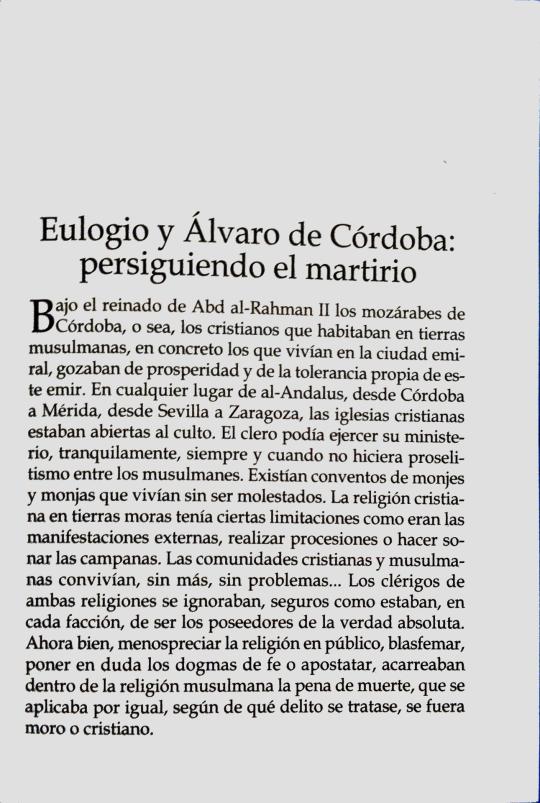
Eulogio and Álvaro de Córdoba:
pursuing martyrdom
Under the reign of Abd al-Rahman II the Mozarabs of Córdoba, that is, the
Christians who lived in Muslim lands, specifically those who lived in the emiral city, enjoyed prosperity and the tolerance typical of this emir. Anywhere in al-Andalus, from Córdoba to Mérida, from Seville to Zaragoza, the Christian churches were open for worship. The clergy could exercise his ministry, quietly, as long as he did not proselytize among the Muslims. There were convents of monks and nuns who lived without being bothered The Christian religion in Moorish lands had certain limitations such as the external manifestations, carrying out processions or ringing the bells. The Christian and Muslim communities lived together, without further ado, without problems... The clerics of both religions ignored each other, sure as were, in each faction, to be the possessors of the absolute truth. Now
well, belittling religion in public, blaspheming, questioning dogmas
of faith or apostatizing, carried within the Muslim religion the penalty of death, which was applied equally, depending on what crime it was, whether if the person was Moor or Christian.
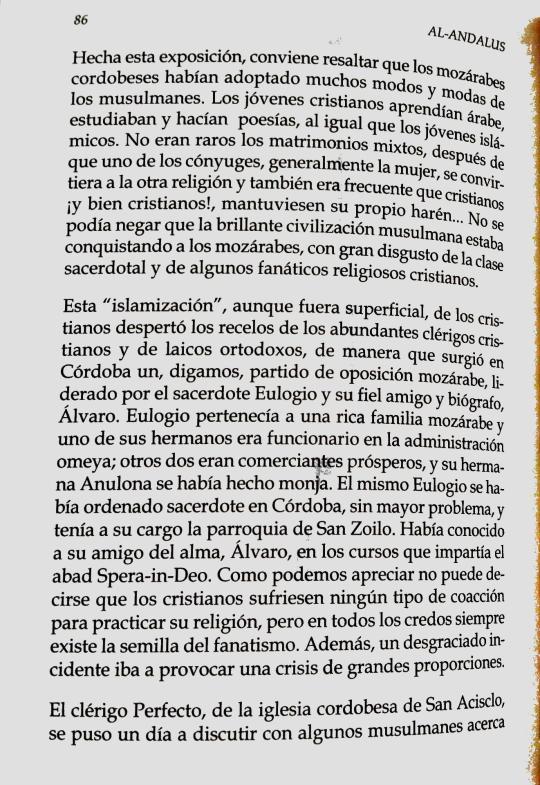
Having made this exposition, it is worth highlighting that the Mozarabs of Cordoba
had adopted many ways and fashions of the Muslims. Young Christians learned Arabic, studied and wrote poetry, just like the Islamic youth. Mixed marriages were not uncommon, after one of the spouses, usually the woman, converts to the other religion and it was also common for Christians, and very Christians, to maintain their own harem... It could not be denied that the brilliant Muslim civilization
was conquering the Mozarabs, to the great displeasure of the priesthood class and some Christian religious fanatics.
This "Islamization", even if it was superficial, of the Christians aroused the
suspicions of the abundant Christian clerics and Orthodox laymen, of way that a, let's say, Mozarabic opposition party emerged in Córdoba, led by the priest Eulogio and his faithful friend and biographer, Álvaro. Eulogio belonged to a rich Mozarabic family and one of his brothers was official in the Umayyad administration; two others were merchants
prosperous, and his sister Anulona had become a nun. Eulogius himself
had been ordained a priest in Córdoba, without much problem, and had his
charge of the parish of San Zoilo. He had met his soul friend, Alvaro in the courses taught by Abbot Spera-in-Deo. As we can see, It can be not said that Christians suffered type of coercion to practice their religion, but in all faiths there is always the seed of fanaticism. Furthermore, an unfortunate incident was going to cause a crisis of great proportions.
The clergyman Perfecto, from the Cordoban church of San Acisclo, one day began to argue with some Muslims about
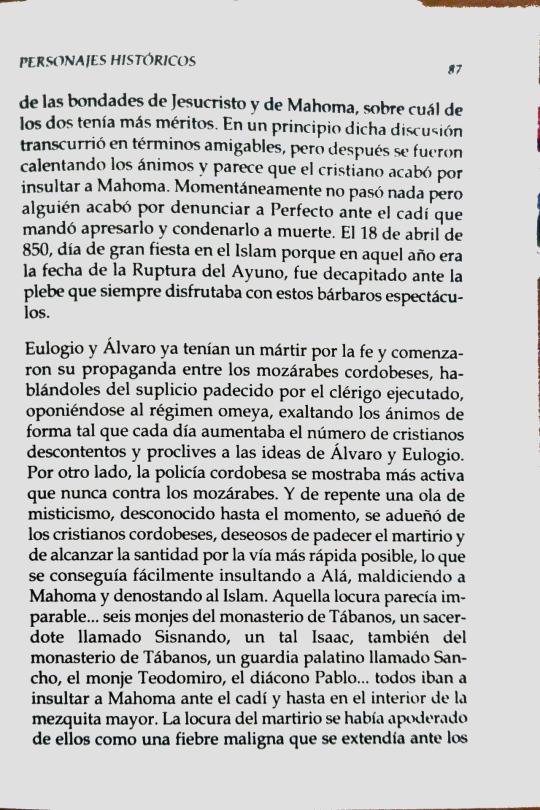
of the goodness of Jesus Christ and Muhammad, about which of the two had more merits. At first the discussion was on friendly terms, but later tempers were heating up and it seems that the Christian ended up insulting Muhammad. Momentarily nothing happened but someone ended up reporting Perfecto to the the cadi who ordered him to be arrested and sentenced to death. On April 18, 850, day of great holiday in Islam because that year was the date of the Breaking of the Fast, it was beheaded before the plebs who always enjoyed these barbaric spectacles.
Eulogio and Álvaro already had a martyr for the faith and began their propaganda among the Mozarabs of Cordoba, telling them about the torture suffered by the clergyman executed, opposing the Umayyad regime, raising spirits in such a way that every day the number of discontented Christians inclined to the ideas of Álvaro and Eulogio. On the other hand, the Córdoba police were more active than never against the Mozarabs. And suddenly a wave of mysticism, unknown until moment, took over the Christians of Cordoba, eager to suffer the martyrdom and achieving sainthood in the quickest way possible, which was achieved
easily insulting Allah, cursing Muhammad and reviling Islam. That madness seemed unstoppable...six monks from the Tábanos monastery, a priest named Sisnando, a certain Isaac, also from the Tábanos monastery, a guard palatine named Sancho, the monk Teodomiro, the deacon Pablo... they all went to insulting Muhammad before the qadi and even inside the main mosque. The madness
of martyrdom had taken hold of them like a malignant fever that spread before the
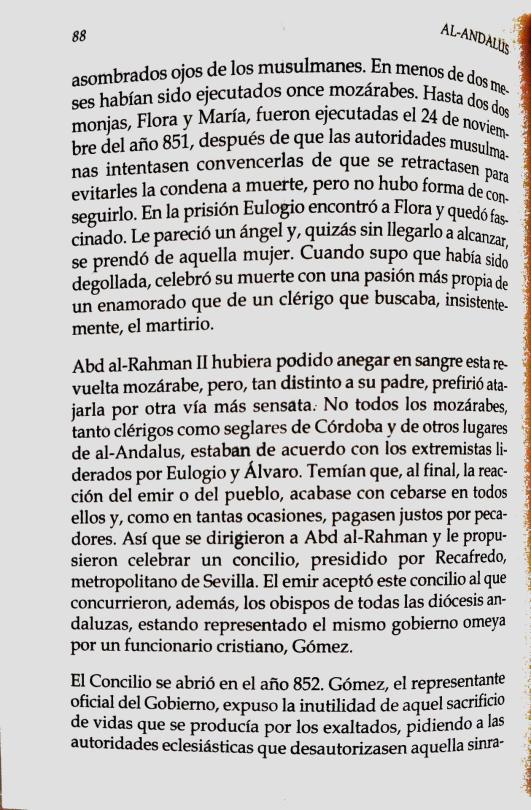
amazed eyes of the Muslims. In less than two months they had been eleven Mozarabs executed. Even two nuns, Flora and María, were executed on November 24, 851, after the Muslim authorities tried to convince them to recant to avoid the death sentence, but there was no way to achieve it. In prison Eulogio found Flora and was fascinated. It seemed like a
angel and, perhaps without reaching him, he fell in love with that woman. When
knew that she had been beheaded, he celebrated her death with a greater passion typical of a lover than of a clergyman who was insistently seeking,
the martyrdom.
Abd al-Rahman II could have drowned this revolt in Mozarabic blood, but, so different from his father, he preferred to tackle it by another sensiblebway. Not all the Mozarabs, both clerics and laymen of Córdoba and from other places in al-Andalus, agreed with the extremists
led by Eulogio and Álvaro. They feared that, in the end, the emir's reaction
or the town, ended up attacking all of them and, as in so many sometimes, the righteous paid for sinners. So they approached Abd al-Rahman and proposed holding a council, presided over by
Recafredo, metropolitan of Seville. The emir accepted this council to which, in addition, the bishops of all the Andalusian dioceses attended, the Umayyad government itself being represented by a Christian official, Gómez.
The Council opened in the year 852. Gómez, the official representative of the
Government, exposed the futility of that sacrifice of lives that occurred
by the exalted, asking the ecclesiastical authorities to disavow that non-
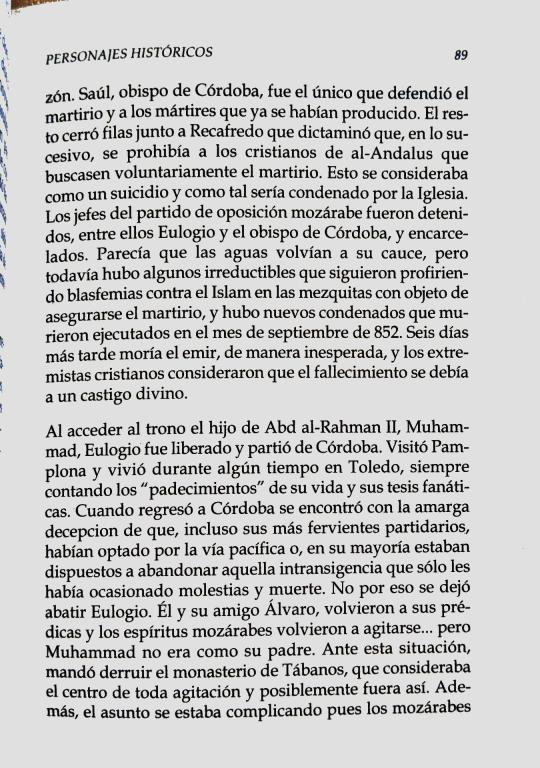
sense. Saúl, bishop of Córdoba, was the only one who defended martyrdom and the martyrs that had already occurred. The rest closed ranks with Recafredo who
ruled that, from now on, the Christians of al-Andalus were prohibited from
voluntarily seek martyrdom. This was considered suicide and
as such he would be condemned by the Church. The leaders of the Mozarabic opposition party were arrested, among them Eulogio and the bishop of Córdoba, and imprisoned. It seemed that the waters were returning to their channel, but there was still some irreducibles who continued uttering blasphemies against Islam in the
mosques in order to ensure martyrdom, and there were new convicts who were executed in the month of September 852. Six days later the emir died, unexpectedly, and the Christian extremists considered that the death was due to divine punishment.
When Abd al-Rahman II's son, Muhammad, acceded to the throne, Eulogius was released and left Córdoba. He visited Pamplona and lived for some time in Toledo, always recounting the "sufferings" of his life and his fanatical theses. When he returned to Córdoba he was met with the bitter disappointment that, even his most fervent supporters had opted for the peaceful route or, for the most part, were willing to abandon that intransigence that had only caused inconvenience and death. That's not why Eulogio let himself be discouraged. Him and his friend Álvaro, they returned to their preachings and the Mozarabic spirits stirred again... but Muhammad was not like his father. Faced with this situation, he ordered the demolition of the Tábanos monastery, which he considered the center of all unrest and possibly it was like that. Furthermore, the matter was becoming complicated because the Toledoan
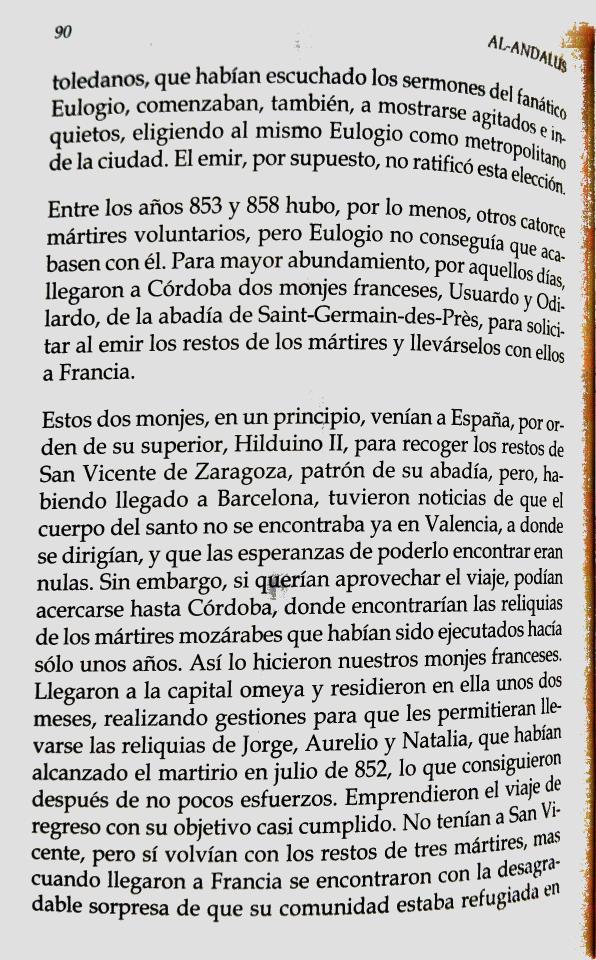
Mozarabs who had listened to the sermons of the fanatic Eulogio, were also beginning to appear agitated and restless, choosing Eulogio as metropolitan of the city. The emir, of course, did not ratified this election.
Between the years 853 and 858 there were at least fourteen other martyrs volunteers, but Eulogio couldn't get them to finish him off. For more abundance, in those days, two French monks arrived in Córdoba,
Usuard and Odilard, from the abbey of Saint-Germain-des-Près, to request the remains of the martyrs from the emir and take them with them to France.
These two monks, at first, came to Spain, by order of their superior, Hildouin II, to collect the remains of S. Vicente de Zaragoza, patron of his abbey, but, having arrived in Barcelona, they had news
that the saint's body was no longer in Valencia, where it was led, and that the hopes of being able to find him were zero.
However, if they wanted to take advantage of the trip, they could go to Córdoba,
where they found the relics of the Mozarabic martyrs who had been
executed only a few years ago. This is what our French monks did. They arrived in the Umayyad capital and lived there for about two months, taking steps to allow them to take the relics of Jorge, Aurelio and Natalia, who had achieved martyrdom in July 852, what they achieved after quite a bit of effort. They started the journey
back with his goal almost accomplished. They did not have S. Vicente, but they did returned with the remains of three martyrs, but when they arrived in France they found themselves with the unpleasant surprise that their community was
refugee in
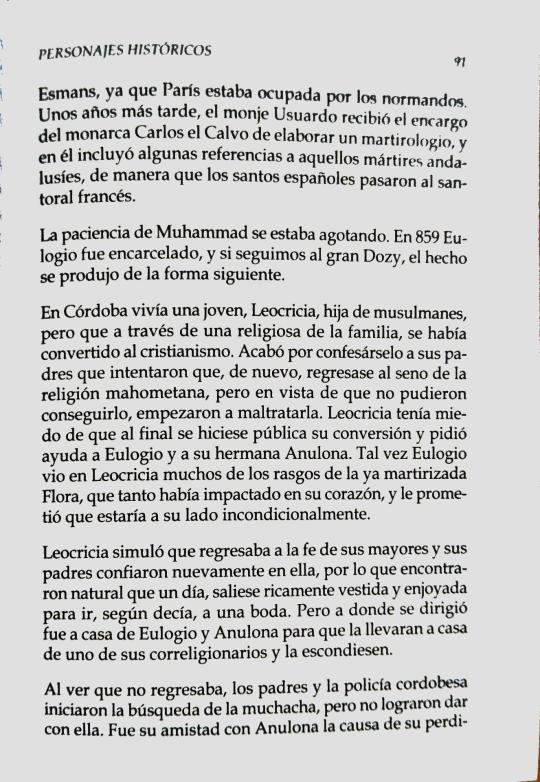
Esmans, since Paris was occupied by the Normans. A few years later, the monk Usuard received the commission from the monarch Charles the Bald to prepare a
martyrology, and in it he included some references to those Andalusian martyrs,
so that the Spanish saints passed to the French saints.
Muhammad's patience was wearing thin. In 859 Eulogio was imprisoned, and if we follow the great Dozy, the event occurred in the following way.
In Córdoba there lived a young woman, Leocricia, daughter of Muslims, but through a nun in the family, had converted to Christianity. She ended up confessing it to his parents who tried to get her to return to the bosom of the Mohammedan religion, but since they could not obtain it,
they began to mistreat her. Leocricia was afraid that in the end her conversion would become public and asked Eulogio and his sister Anulona for help. Maybe Eulogio saw
in Leocricia many of the traits of the already martyred Flora, who had so much
shocked in his heart, and he promised that he would be by his side unconditionally.
Leocricia pretended to return to the faith of her elders and her parents trusted
again in it, so they found it natural that one day, it would come out richly dressed and jeweled to go, as she said, to a wedding. But where she went to Eulogio and Anulona's house so they could take her to the house of one of her coreligionists and hid her.
Seeing that she did not return, the parents and the Córdoba police began the search
of the girl, but they could not find her. It was his friendship with Anulona that
cause of her perdi-
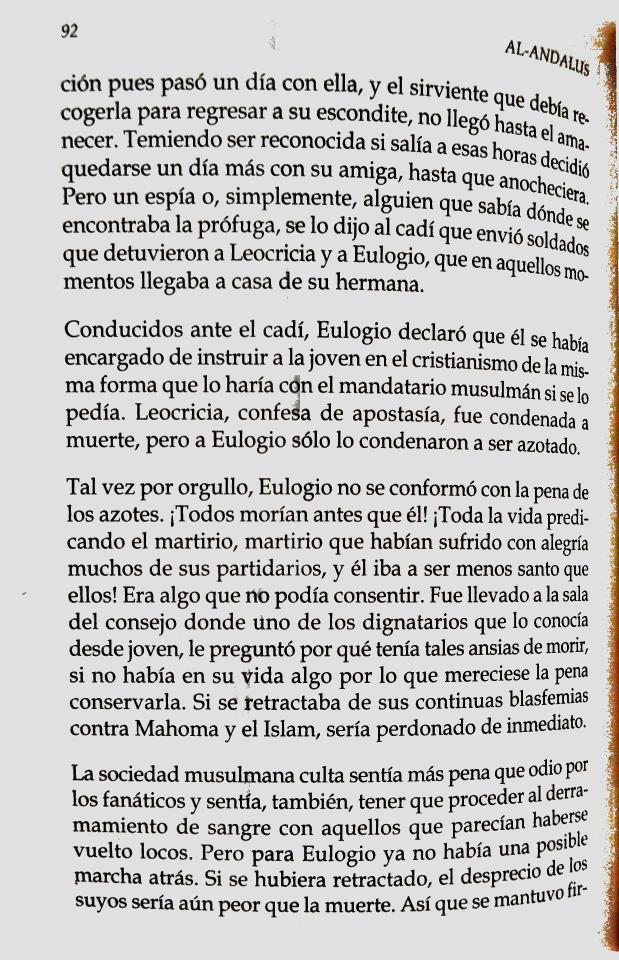
tion because she spent a day with her, and the servant who was to pick her up to
return to her hiding place, she did not arrive until dawn. Fearing to be recognized if she went out at that time, she decided to stay one more day with her friend, until nightfall. But a spy or simply someone who knew where the fugitive was, told the cadi who sent soldiers to arrest Leocricia and Eulogio, who at that time was reaching
his sister's house.
Brought before the cadi, Eulogio declared that he had taken care of instruct the young woman in Christianity in the same way as he would with the Muslim leader if he asked. Leocricia, confessed of apostasy,
was sentenced to death, but Eulogio was only sentenced to be whipped.
Perhaps out of pride, Eulogio did not settle for the punishment of whipping. Everyone died before him! All his life preaching martyrdom, martyrdom that many of his supporters had suffered with joy, and he
I was going to be less holy than them! It was something he couldn't consent. He was taken to the council room where one of the dignitaries who knew him since he was young, he asked him why he had such a desire to die, if there was no something in his life worth keeping. If he retracted
of his continued blasphemies against Muhammad and Islam, he would be forgiven immediately.
The cultured Muslim society felt more pity than hatred for the fanatics and they also felt that they had to proceed to shed blood with those who seemed to have gone crazy. But for Eulogio there was no longer a possible retreat. If he had retracted, the contempt of his people would be even worse than death. So he stood firm
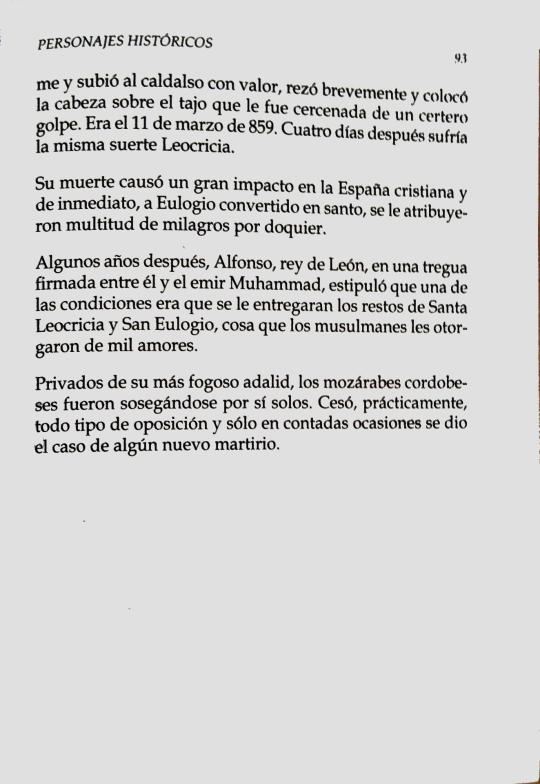
and he bravely climbed into the scaffold, prayed briefly and placed his head on the
slash that was severed with a well-aimed blow. It was March 11, 859. Four days later Leocricia suffered the same fate.
His death caused a great impact in Christian Spain and immediately,
Eulogio became a saint, a multitude of miracles were attributed to him
everywhere.
Some years later, Alfonso, king of León, in a truce signed between him and the emir Muhammad, stipulated that one of the conditions was that the remains of S. Leocricia and S. Eulogio would be handed over, something that Muslims gave them a thousand loves.
Deprived of their most fiery champion, the Mozarabs of Córdoba were calming down on their own. Practically all types of opposition ceased and only on rare occasions there was the case of a new martyrdom.
#al andalus. historical figures#al andalus. personajes históricos#al andalus#book scans#al andalus history#bookblr#historyblr#spanish history#emirate of cordoba#eulogio de córdoba#álvaro de córdoba#emirato de córdoba
15 notes
·
View notes